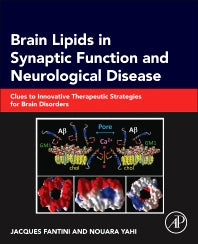Freshly Printed - allow 10 days lead
Couldn't load pickup availability
Brain Lipids in Synaptic Function and Neurological Disease
Clues to Innovative Therapeutic Strategies for Brain Disorders
A reference on brain lipid structure and function, discussing the crucial roles they play at synapses and the neurological disorders associated with their dysfunction
Jacques Fantini (Author), Nouara Yahi (Author)
9780128001110, Elsevier Science
Hardback, published 3 July 2015
398 pages
23.4 x 19 x 2.6 cm, 0.95 kg
Lipids are the most abundant organic compounds found in the brain, accounting for up to 50% of its dry weight. The brain lipidome includes several thousands of distinct biochemical structures whose expression may greatly vary according to age, gender, brain region, cell type, as well as subcellular localization. In synaptic membranes, brain lipids specifically interact with neurotransmitter receptors and control their activity. Moreover, brain lipids play a key role in the generation and neurotoxicity of amyloidogenic proteins involved in the pathophysiology of neurological diseases. The aim of this book is to provide for the first time a comprehensive overview of brain lipid structures, and to explain the roles of these lipids in synaptic function, and in neurodegenerative diseases, including Alzheimer’s, Creutzfeldt-Jakob’s and Parkinson’s. To conclude the book, the authors present new ideas that can drive innovative therapeutic strategies based on the knowledge of the role of lipids in brain disorders.
Part I. Brain Lipids1. Chemical basis of lipid biochemistry2. Brain membranes3. Lipid metabolism and oxidation in neurons and glial cells4. Variations of brain lipid content
Part II. Brain Lipids and Synaptic Functions5. A molecular view of the synapse6. Protein-lipid interactions in the brain7. Lipid regulation of receptor function
Part III. Brain Lipids and Neurodegenerative Disease8. Common mechanisms in neurodegenerative diseases9. Creutzfeldt-Jakob’s disease10. Parkinson’s disease11. Alzheimer’s disease
Part IV. Brain Pathogens and Amyloidogenic Proteins: The Lipid Connection12. Viral and bacterial diseases13. A unifying theory14. Therapeutic strategies for neurodegenerative diseases
Subject Areas: Neurology & clinical neurophysiology [MJN], Physiology [MFG]


